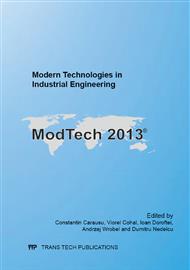p.305
p.310
p.316
p.322
p.328
p.334
p.340
p.346
p.351
Design and Manufacturing Preparation of a Patient Specific Acetabular Cage
Abstract:
Total hip arthoplasty or hip replacement is today a common and highly successful a surgical procedure. However, in the revision artoplasty the procedure is more complicated, as standard devices have to be adapted to different shapes of acetabular defects, which are patient specific especially when they are bigger and wider spread. This kind of big defects, sever acetabular defects, pelvic discontinuity, defects resulted from tumor problems, protrusion, can usually be addressed with a standard Burch-Schneider Antiprotrusio Cage or a Mueller Ring in order to restore the mechanics and the true center of the hip. This paper proposes a design process and manufacturing preparation for a patient specific acetabular cage. The design is intended to fix problems that standard cages sometimes do not resolve, for example insufficient fixation due to the fact that the inferior flange did not engage the ischium, problems of bone graft resorption and in the same time tries to remain an affordable solution. The design process uses as input information the 3D reconstruction of the patient hip from CT scan. Important parameters like the position of the true center of rotation, acetabular anteversion and inclination are determined and calculated. Other parameters, such as number of fixing screws and their designated holes or the amount of bone to be covered with the custom acetabular cage (fixation surface), are proposed by orthopaedic specialist. The design methodology relays on commercial software, such as Solid Works for CAD, 3D Doctor for 3D bone reconstruction from the CT scans or other software for different file transformations. The model was optimized to be produced through direct metal laser-sintering (DMLS). Regarding the results, the particular implant was designed and optimized for fabrication and it is available to be produced. During the design process, although a systematized process was undertaken and implemented, some activities could not be done in systematic, repeatable way. Nevertheless, a design process strategy was established, so that the design would match the requirements of such implant and also a requirements list for the type and form of information needed for this kind of design. Also, we concluded that using software to automate some of the operations that were done manually by the operator would help decrees the design time and improve the repeatability of the process.
Info:
Periodical:
Pages:
328-333
Citation:
Online since:
November 2013
Authors:
Price:
Сopyright:
© 2014 Trans Tech Publications Ltd. All Rights Reserved
Share:
Citation:


